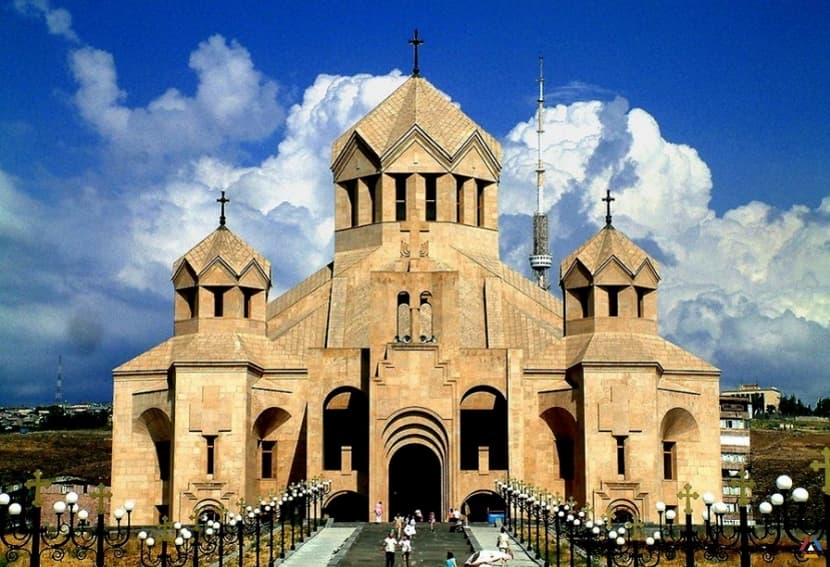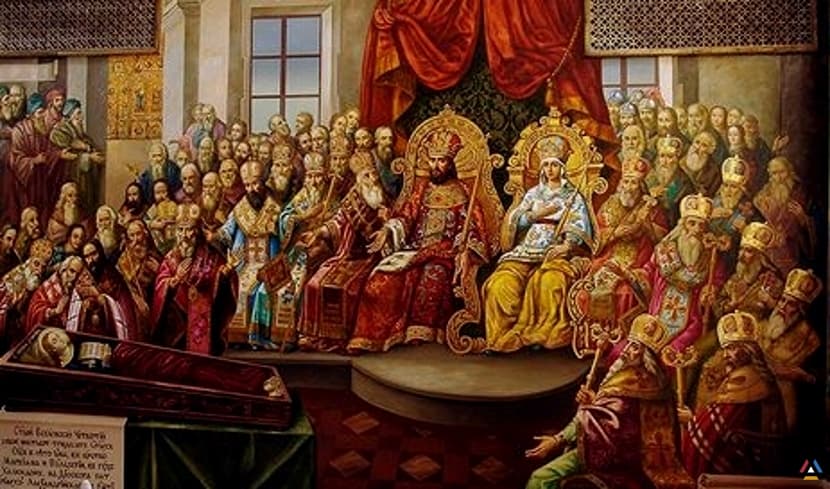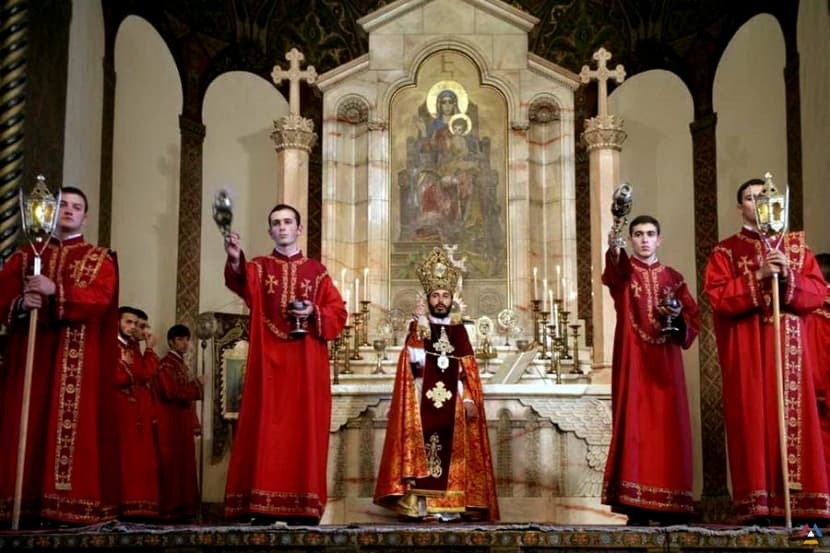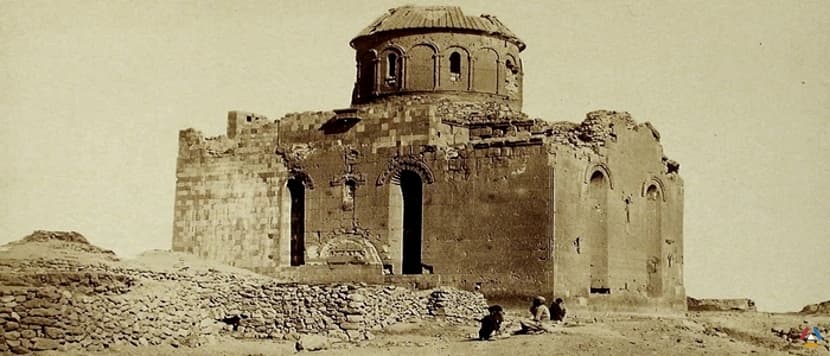
Armenian Apostolic Church

About the Armenian Apostolic Church, its history, features and differences from the Orthodox
In Armenia, the Armenian Apostolic Church is still called the Unified Holy Ecumenical Apostolic Orthodox Armenian Church.

It is an anti-Chalcedonian community, uniting mainly Armenians, with a center located in the Etchmiadzin Monastery in the city of Vagharshapat. According to ancient legends, the preaching in Armenia was conducted by the apostles Bardughimeos and Tadeos, from here came its name - the apostolic. The date of adoption of Orthodoxy is considered to be the 301 year, but, according to some historians, the baptism of Armenia occurred in 313 after the proclamation of the Edict of Milan. At that time, thanks to St. Gregory the Illuminator, the establishment of Orthodoxy took place among the Armenians. The successor of Gregory the Illuminator was his son Aristakes, who took part in the 1st Ecumenical Council. The Armenian Church also participated in the 2nd and 3rd Ecumenical Councils. But the 4th Ecumenical Council, which took place in 451, was held without the participation of representatives of the Armenian Apostolic Church, and the decisions made on it were distorted because of an incorrect translation. The non-adoption of the Ecumenical decisions caused the gap between the anti-Chalcedonites and the Orthodox in the Armenia, which shook the Christian life of Armenia for two centuries. In this period, reconciliations or breaks occurred with the Orthodox Church. This continued until the 726, when the Manazkert Council was held, after which Orthodoxy was rejected by the Christians of Armenia. The Armenian Apostolic Church began to exist as an anti-Chalcedonite community, during various periods consisting of territorially independent canonical allotments, recognizing the spiritual supremacy of the Catholicos of all the Armenians, in the monastery of Echmiadzin.
The Armenian Church began to use the Christological terminology created by Saint Cyril of Alexandria, to recognize the 7 sacraments, to honor the Virgin and icons. The Armenian Apostolic Church is widespread throughout the world, especially in those countries where Armenians live. This is the largest religious community in Armenia, with an extensive network of dioceses located in the countries of the Middle East and the CIS, Europe and America.
The history of the Armenian Apostolic Charch

Many people know the history of the Armenian Apostolic Church, because its majestic, amazing architecture churches are located in many cities of Russia, the CIS and abroad. Tourists coming to Moscow, Krasnodar, Rostov-on-Don, St. Petersburg, Kislovodsk and many other cities, are among the attractions which people are in hurry to see the Armenian Church, to hear its history. It became interesting to many people due to the popular Armenian TV series, which showed baptism in the Armenian church or other rites. But neither the screen, nor the photo can convey stunning beauty, the splendor of the decoration, the special atmosphere prevailing in the Armenian shrines. That’s why, the guests of Moscow or Petersburg rush to the
Armenian Church by Olympic or Nevsky Prospects[/b]
In the history of the Armenian Apostolic Church, many events have occurred over several thousand years. Little information was preserved about its oldest period, because only at the beginning of the 5th century the Armenian alphabet appeared. Therefore, the historical events in the life of the Armenian church were transmitted orally between generations. And only in the 5th century, after the emergence of the Armenian language, its history began to be writed, due to which it was well preserved and survived to our day.
A number of ancient historical sources confirm that in Armenia Christianity began to be preached by the holy apostles Tadevos and Bartholomew, who are considered the founders of the Armenian Apostolic Church. As it is writed in the Holy Scripture, after the Savior ascendant, his disciple and follower Tadevos made his way to Armenia to preach God's Word. He turned to the faith of Christ many Armenians, among them was also the daughter of the King Sanatruk. All professing Christianity, including the princess, the king did not spare and ordered to be executed.
Several years passed and the apostle Bartholomew, who preached in Persia, made a trip to Armenia. There they converted to the Christian faith the king’s sister and many nobles, and then Bartholomew suffered the fate of Tadevos. It is said in one of the historical writings that the disciples of the apostles Tadevos and Bartholomew, after their death, settled in gorges on the Euphrates River. After the becaming Artashes king of Armenia, they came to the palace and preached the gospel. According to historical evidence, in the 1st century Christianity spread in Armenia also due to many internal and external factors. For example, the Christian faith was adopted in some countries adjacent to it and having close ties with it in the fields of trade, politics and culture. All this contributed to the creation of favorable conditions for Christianity to spread as actively as possible in Armenia.
Also, in the 1st - 3rd centuries, Lesser Armenia was attributed to the Roman province for political reasons therefore it is believed that through it the Christian teaching spread to Greater Armenia. The fact that Christianity spread throughout Armenia was also facilitated by the presence of Jewish communities in it. More, Jewish settlements were in many of the main cities of the state. So in one of the ancient books written back in 197, Armenians were mentioned among the peoples who adopted the Christian faith. This fact is confirmed by other historical sources. From the end of the 2nd to the beginning of the 3rd century, the Christians of Armenia were persecuted by the kings and their successors. The proofs of persecution can be found in various historical documents. And only in 301, The King Trdat, was proclaimed the Christianity as the state religion. There was a religious separation of Armenia from Iran, which sought to subjugate it. The main role of the adoption of the Christian faith was given to Gregory the Illuminator who was the first Catholicos of the Church of Armenia, as confirmed by ancient manuscripts.
A significant event of the 303 was the construction of the Cathedral of Etchmiadzin - a religious center for all Armenians, in which the Catholicos and the supreme patriarch of all Armenians stayed. The second half of the 5th century was marked by a gap that occurred in the Christian environment of Armenia due to different attitudes to the resolutions of the 4th Ecumenical Council. Representatives of the Armenia were not present, and the decisions of the meeting were distorted, since the Greek word was translated as a person by Armenian teachers, since they did not know its exact meaning.
The continuation of the gap was also related to the arrival of monophysites in Armenia, who disseminated false information that Nestorianism was restored at the Ecumenical Council. This served as an impetus to the fact that the Armenian Church announced that it did not accept the decisions of the Council. The split began between non-Chalcedonites and Orthodox Armenians, which lasted for two centuries and led to frequent upheavals in the religious life of Armenia. During this period, the attitude of the church elite of Armenia towards the Ecumenical Council and its decisions was repeatedly changed, which occurred under the influence of various historical and political events.
And now, despite the presence of a large amount of historical proofs and documents, the Armenian church and its history, as well as the Armenian language, often become the causes of disputes between historians and religious figures. There are many Armenian historical series on which the Armenian church is also mentioned. Therefore, everyone who is interested in the history of this ancient nation and its religion will know a lot of useful information from historical films with fascinating stories.
Features of the Armenian Church

Many people may wonder - what is the difference between the Armenian church and the Orthodox? To get an answer you need to familiarize yourself with the dogmatic features of the Armenian church. Her theology was taken as a basis for the terminology of the great church saints who served in the 4th and 5th century. The terms received from Athanasius of Alexandria, Gregory the Theologian, Cyril of Alexandria, Basil the Great and other saints, as well as the decisions that were adopted at the first 3 Ecumenical Meetings, became widespread. As for the break with the Orthodox Church, it occurred primarily due to the question of the two natures united in Christ. According to the Orthodox Church, it is professed that Christ has one face, combining two natures - divine and human. The Armenian Church preaches the doctrine of one person and one nature. Therefore, it condemned the decision made at the 4th Ecumenical Assembly. In its turn, the Orthodox Church recognized the Armenian Church as such a church, which is in the heresy of Monophysitism.
Numerous disputes between the Orthodox and Armenian churches have been going on for many centuries, but the lack of church unity does not affect good neighborly relations between Armenia and Russia, as well as other CIS countries and abroad. And confirmation of this is the presence of Armenian communities and temples in many countries of the world, where not only Armenians can come.
Starting from the middle of centuries and almost until recently, the Orthodox Church represented the Armenian as Monophysite, and the Armenian Orthodox Church as Diophysite

The dialogue between the ministers of the Armenian and Orthodox churches began in 1965. Over time, representatives of the two religions came to the conclusion that the Orthodox Church cannot be a Diophysite, since this teaching is Nestorianism rejected by the Orthodox churches. They also agreed that the Armenian church does not belong to the Monophysites, since such a doctrine relates to the Eutykhian heresy, which the Armenian church at one time anathematized. And now, dialogues between the ministers of the Armenian and Orthodox churches continue. In their process, many issues that are important for both sides are resolved.
The Armenian Church is not only one of the most ancient religions, but also one of the most widespread in the world. This is due to the fact that millions of Armenians live in different countries of the world, including in Russia. Therefore, in many large and medium cities of the Russian Federation, temples rise to a great extent, where the Armenians come. The addresses of the shrines are known not only to local residents. Tourists from all over the world are interested in the unique architecture of Armenian churches and cathedrals, their interior decoration, the services and rituals held in them.
The history of the church of Armenia is no less interesting, because the Armenians were the first nation who adopted the Christianity as the state religion. Many events have occurred since then, which have affected not only at the history of the church, but also the country itself. Armenians sacredly honor their traditions and customs they are equally reverent about the religion, so they erect their churches wherever there are communities. There they turn in prayers to the Lord, baptize their children, get married, and sing the funeral for the dead.

Armenian churches are historical and architectural monuments, included in the lists of famous attractions, that’s why they call grate interest among residents and visitors of the cities in which they are located. Often, majestic shrines can be seen in popular Armenian TV series, telling about ancient and modern times, historical events and life dramas. Armenian churches are located in picturesque, cozy corners, on beautiful streets, where other ancient buildings have been saved. You can often see their photos in guidebooks and travel booklets, in videos of tour operators, in various television shows. But many people prefer to see with their own eyes the unique architecture of the Armenian churches in all its greatness.
0
18:44 25-04-2020






 Հայերեն
Հայերեն  Русский
Русский
Dear visitor, if you have a minute please leave your comment about the film or series. Thank you.